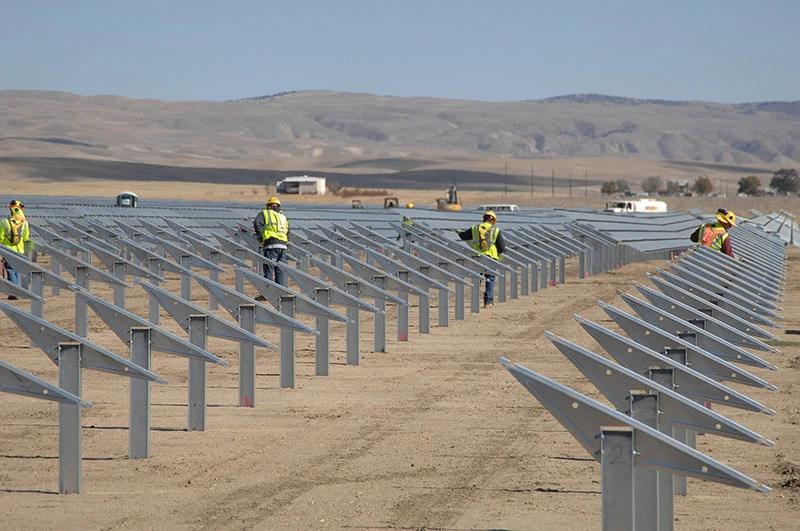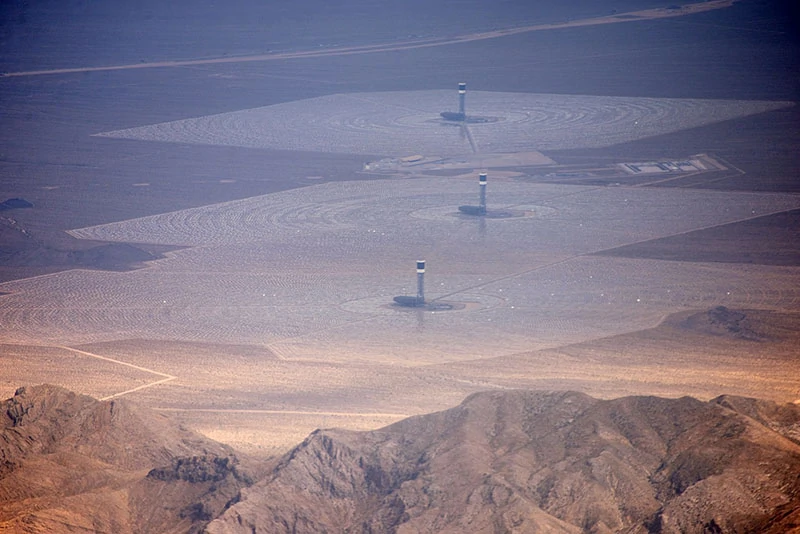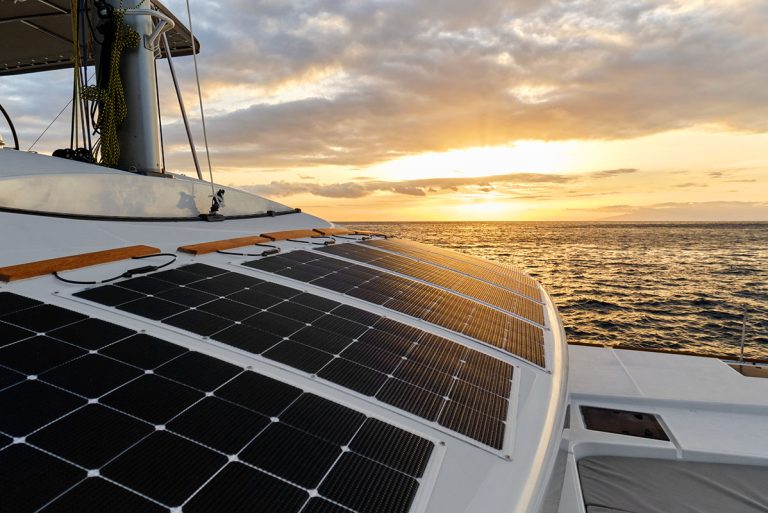Perhaps you’re looking to buy a new house and are considering properties near a solar farm, or maybe a new solar farm is being proposed in your local area. Sure, you’re a fan of solar energy and its benefits, but do you really want to live next to a solar plant?
We’ll highlight the advantages and disadvantages of living next to a solar farm to help you understand whether this is something you want to do.
What are the advantages of living next to a solar farm?
According to the EIA, there are over 2,500 utility-scale solar photovoltaic (PV) facilities in the US which generate electricity. Furthermore, the US government is incentivizing companies to launch new projects, so additional solar plants are being built all the time.
Aside from the wider positive impacts on the environment of solar energy, living next to a solar farm – or near a solar farm – also has a set of advantages.
1. Employment opportunities
One of the key advantages of living next to a solar farm is that it provides plenty of opportunities for employment. A single solar farm can employ up to 500 technical staff and manual workers, bringing a wealth of jobs across various fields to the area.

Source: Wikimedia / Pacific Southwest Region from Sacramento, US
Furthermore, as the world moves away from fossil fuels and towards sustainable sources of energy, you can be assured that the solar farm will continue to offer secure employment in the years to come. On the other hand, coal and oil are being phased out in many parts of the world, so a career in these industries is probably not a good choice for the future.
Aside from direct jobs, a large project like a solar farm means plenty of business opportunities, indirectly generating jobs in the local area. For example, the employees of the solar plant will need housing, food, and a range of other goods and services – all of which boosts growth and wealth in surrounding population centers. Therefore, living next to a solar farm brings a distinct advantage to those seeking employment in the energy sector.
2. Reduced cost of energy
Although solar infrastructure is expensive to build, the government is incentivizing solar energy in a variety of ways as part of policies to promote green energy, making it one of the cheapest types of power plants to build.
For example, the federal government gives companies a tax credit of up to 30% when building solar generation projects, making them cheaper to set up than coal power plants and other forms of energy generation relying on fossil fuels.
This makes renewable energy the cheapest form of energy to produce.
According to research by IRENA:
- Wind costs $0.04 per kWh to produce.
- Solar costs $0.10 per kWh to produce.
- Energy from fossil fuels, on the other hand, costs around $0.17 to produce.
As a consumer, you’ll be able to enjoy the benefits of cheap power on your doorstep. Some companies give significant discounts or even free power to their neighbors.
You also won’t need to worry about power interruptions, as solar panels are a reliable source of energy. Solar farms have large batteries that store the energy absorbed during the day, meaning that they can supply power 24/7.
Furthermore, if you live very close to the solar farm, the electricity doesn’t have to travel on a bunch of power lines that could be broken or damaged, causing power cuts. Solar plants usually have on-site engineers who instantly respond to any technical problems.
So living next to a solar farm plant means you’ll enjoy constant, reliable energy.
3. Solar farms are quiet
Another advantage of solar-generating projects is that they are very quiet, compared to other types of power plants at least. Solar panels do not generate any noise, and the batteries and other infrastructure needs only minimal upkeep.
Add to this that most solar plants are small operations, and you won’t notice large numbers of trucks or hundreds of workers coming and going from a solar project, unlike coal or nuclear power stations.
Additionally, solar farms are typically built-in remote, low-populated areas, so moving in close to a solar plant will usually mean you’ll usually enjoy a tranquil location.
What are the disadvantages of living near a solar farm?
As we’ve discussed living next to a solar farm, or otherwise near a solar farm can have a some benefits. But on the other hand, the close proximity of so many solar panels can also have its disadvantages.
1. Living next to a solar farm could be harmful to your health
Solar power plants give out electromagnetic radiation which may reduce life expectancy! This radiation doesn’t come from the panels themselves, but rather the industrial equipment used to store the energy the panels produce.
Some people suffer from electromagnetic hypersensitivity, which can lead to health problems ranging from mild to severe, according to the WHO. It should be noted that this condition is rare and most people are likely to have very few or no health issues from living next to a solar farm or solar power plant.
However, for those people who suffer from the condition it can be serious, and may even shorten their life. So if you live near a solar plant and find yourself suffering from symptoms such as headaches or restlessness, go and see your doctor as soon as possible.
Furthermore, if the solar project doesn’t handle its waste properly, this could also be harmful to the health of those living nearby.
Of course, other types of power plants are arguably more harmful to the health of those living nearby than solar plants. This is particularly the case with coal plants, which cause a range of health problems for those living nearby, including asthma, developmental problems, and depression.
2. Habitat degradation
Although solar power is more environmentally-friendly than non-renewable forms of energy, particularly when you consider greenhouse emissions, this doesn’t mean they don’t have any negative impacts on the environment. Specifically, solar power plants can cause significant habitat degradation.
To produce solar power on an industrial scale, you need a vast amount of land. Building solar farms usually means displacing large numbers of mammals, birds, insects, and other wildlife.
In the US, large solar projects are mostly built in the West’s so-called empty deserts. However, these areas are actually important habitats for a large number of animals.
For example, the highly-controversial Ivanpah solar project went ahead in California’s Mojave Desert despite intense criticism from wildlife conservationists. This meant destroying the habitat of thousands of desert tortoises, an endangered species.

Source: Wikimedia / Craig Butz
Furthermore, large-scale solar farms may be dangerous and even deadly for birds in the area. Dead birds have been found around solar projects like Ivanpah, with some arguing this is caused by intense rays reflected from the solar panels.
At the same time, some solar farms are able to combine renewable energy production with agricultural practices including raising livestock. Called Agrivoltaics, such practice makes renewable energy production truly sustainable in more ways than one.
3. Solar farms are unsightly
By their nature, solar farms mean clearing trees and other vegetation and replacing it with row upon row of PV panels, which probably isn’t the view you’d prefer from your nice big bay windows!
When setting up a solar farm, companies usually try to minimize the negative impacts on the surrounding community. However, often panels may need to be angled in a particular direction to catch the most sunlight, which may not be the best result for those living next door.

Source: Wikimedia / muffinn
Furthermore, angling panels in one direction could be ideal for the neighbors on one side, but problematic for those living on the other.
However, it must be said that solar panels are much less visually-intrusive than industrial wind turbines, which definitely dominate the landscape. So if you want to support renewable energy and address global warming, having a solar-generating project in your neighborhood might not be so bad!
4. Can negatively affect property value
Having a solar project in your backyard probably won’t do the value of your home any favors. Thanks mostly to aesthetic concerns, potential buyers may be put off by a solar farm in the neighborhood.
In contrast, a home solar system will increase the resale value of your home. However, as renewable energy and solar farms, in particular, become more commonplace in coming years, this concern is likely to become less relevant.
Should I live near a solar farm?
There’s no doubt that renewables are the future: wind, solar, and other forms of renewable energy are the key to addressing climate change and other forms of environmental destruction, as well as being sustainable for years to come.
However, when it comes to living next to a solar farm, or near one, the picture is not so clear.
You’ll enjoy cheap, reliable energy, job opportunities, and these facilities are much quieter than other types of power plants. However, they also cause habitat destruction, are unsightly, could decrease the value of your property, and may have severe health impacts for some people.
Overall, it may be better to have your own solar system – these are safe, reliable, eco-friendly and will reduce your energy bill without destroying habitats.
If you’re interested in setting up your own solar system at home, take a look at our guides to building your own DIY solar system, the best solar panels, and on-grid vs off-grid solar systems.













